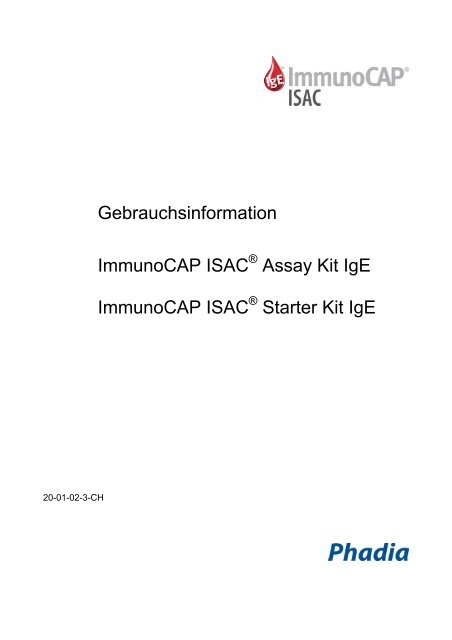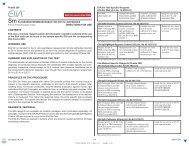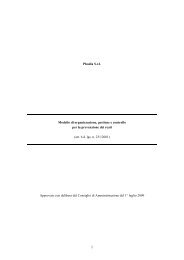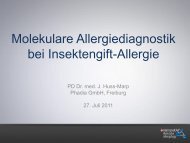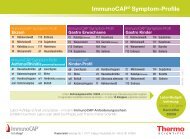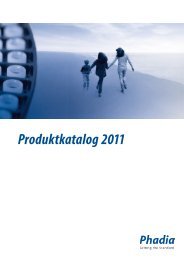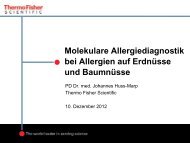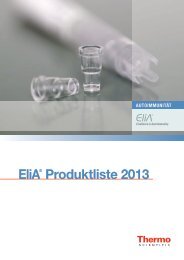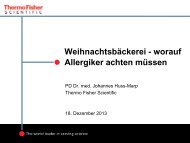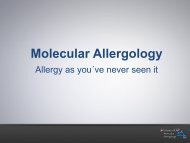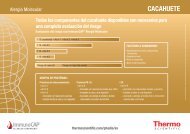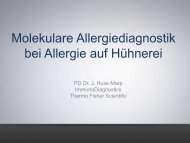Gebrauchsinformation ImmunoCAP ISAC Assay Kit IgE ... - Phadia
Gebrauchsinformation ImmunoCAP ISAC Assay Kit IgE ... - Phadia
Gebrauchsinformation ImmunoCAP ISAC Assay Kit IgE ... - Phadia
Create successful ePaper yourself
Turn your PDF publications into a flip-book with our unique Google optimized e-Paper software.
20-01-02-3-CH<br />
<strong>Gebrauchsinformation</strong><br />
<strong>ImmunoCAP</strong> <strong>ISAC</strong> ® <strong>Assay</strong> <strong>Kit</strong> <strong>IgE</strong><br />
<strong>ImmunoCAP</strong> <strong>ISAC</strong> ® Starter <strong>Kit</strong> <strong>IgE</strong>
Trademarks/Marques/Varemerker/Warenzeichen/Varemaerker/<br />
Marchi despositati/Marchas registradas/Varumärken/Marcas registradas<br />
Die folgenden Bezeichnungen sind registrierte Warenzeichen der <strong>Phadia</strong> AB: <strong>ImmunoCAP</strong> ® ,<br />
<strong>ImmunoCAP</strong> <strong>ISAC</strong> ®<br />
Die folgenden Bezeichnungen sind registrierte Warenzeichen der <strong>Phadia</strong> Multiplexing Diagnostics<br />
GmbH:<br />
<strong>ISAC</strong><br />
Die folgenden Bezeichnungen sind registrierte Warenzeichen der CapitalBio Corporation: LuxScan<br />
Referenzen<br />
Siehe Seite 12<br />
Entwickelt von:<br />
<strong>Phadia</strong> Multiplexing Diagnostics GmbH, Donau-City-Strasse 1, A-1220 Wien, Österreich<br />
Ausgabe April 2008<br />
Überarbeitet September 2009<br />
© <strong>Phadia</strong> AB, Uppsala, Schweden<br />
Seite 2
ANWENDUNGSGEBIET<br />
<strong>ImmunoCAP</strong> <strong>ISAC</strong> ® ist ein In-vitro-Test zur quantitativen Bestimmung von spezifischen <strong>IgE</strong>-<br />
Antikörpern im menschlichen Serum oder Plasma. <strong>ImmunoCAP</strong> <strong>ISAC</strong> ® ist für die In-vitro-<br />
Diagnostik in Verbindung mit anderen klinischen Befunden bestimmt und wurde für den Einsatz<br />
durch medizinisches Fachpersonal in klinischen Laboratorien entwickelt.<br />
TESTPRINZIP<br />
<strong>ImmunoCAP</strong> <strong>ISAC</strong> ® ist ein Festphasen-Immunoassay. Für den Nachweis spezifischer <strong>IgE</strong>-<br />
Antikörper werden Allergenkomponenten, die im Mikroarray-Format auf einem festen Träger<br />
immobilisiert wurden, mit humanen Serum- oder Plasmaproben inkubiert. Durch Zugabe eines<br />
Fluoreszenz-markierten anti-humanen <strong>IgE</strong>-Antikörpers werden die, an die immobilisierten Allergenkomponenten<br />
gebundenen spezifischen <strong>IgE</strong>-Antikörper, nachgewiesen. Die Fluoreszenz wird<br />
mittels eines geeigneten Mikroarray-Scanners gemessen. Die <strong>ISAC</strong>-Standardeinheiten (<strong>ISAC</strong><br />
Standardized Units, ISU) werden ermittelt und die Testergebnisse mit einer speziellen Software<br />
(MIA - Microarray Image Analysis Software) analysiert.<br />
Abb. 1.<br />
Oben links: Schematische<br />
Darstellung der Mikroarray-<br />
Anordnung der Allergenkomponenten.<br />
Oben rechts: Schematische<br />
Darstellung des Testprinzips.<br />
Allergenkomponenten werden<br />
kovalent an die feste Phase<br />
gebunden. Allergenspezifische<br />
<strong>IgE</strong>-Antikörper werden durch<br />
Fluoreszenz-markierte antihumane<br />
<strong>IgE</strong>-Antikörper nachgewiesen.<br />
Unten links: Scan des<br />
Fluoreszenz-Laser-Scanners,<br />
der die unterschiedlichen<br />
Fluoreszenzintensitäten auf einer<br />
Falschfarbenskala farblich von<br />
schwarz (negativ) bis weiss (stark<br />
positiv) darstellt.<br />
Unten rechts: Schematische<br />
Darstellung des <strong>ImmunoCAP</strong> <strong>ISAC</strong> ®<br />
Patientenberichts.<br />
Seite 3
REAGENZIEN<br />
Die <strong>ImmunoCAP</strong> <strong>ISAC</strong> ® <strong>Assay</strong> <strong>Kit</strong>s oder Starter <strong>Kit</strong>s enthalten 5 Glasträger und alle für die<br />
Testausführung notwendigen Reagenzien. Das Verfallsdatum, die Charge und die<br />
Lagertemperatur des jeweiligen <strong>Kit</strong>s sind auf dem äußeren Etikett verzeichnet. Jeder Bestandteil<br />
der Packung ist so lange haltbar, wie es auf dem jeweiligen Etikett angegeben ist.<br />
Das Vermischen von Reagenzien wird nicht empfohlen.<br />
<strong>ImmunoCAP</strong> <strong>ISAC</strong> ® Starter <strong>Kit</strong> <strong>IgE</strong> (Art.-Nr. 81-1001-01)<br />
(für 20 Bestimmungen)<br />
<strong>ImmunoCAP</strong> <strong>ISAC</strong> ®<br />
Komponente A<br />
(20fach konzentrierter Puffer)<br />
200 ml<br />
<strong>IgE</strong>-Detektionsantikörper<br />
(fluoreszierendes anti-humanes <strong>IgE</strong>-<br />
Konjugat) 0,5 ml<br />
<strong>IgE</strong>-Kontrollserum<br />
(humanes Serum)<br />
Natriumazid < 0,1%, 50 µl<br />
5 Glasträger<br />
mit je 4<br />
Analysenfeldern<br />
Waschschale 2 Schalen für 10<br />
Glasträger<br />
Gebrauchsfertig<br />
Lagerung bei 2 – 8°C bis zum<br />
Verfallsdatum<br />
Bitte den <strong>Kit</strong> auf Zimmertemperatur<br />
bringen, bevor das Vakuumsiegel<br />
geöffnet wird.<br />
Nach dem Öffnen des Vakuumsiegels<br />
können die Chips für 6 Wochen<br />
aufbewahrt werden, wenn sie trocken,<br />
dunkel und bei 18 – 32°C gelagert<br />
werden.<br />
1 Flasche Lagerung bei 2 – 8°C bis zum<br />
Verfallsdatum<br />
1 Fläschchen Gebrauchsfertig.<br />
Lagerung bei 2 – 8°C bis zum<br />
Verfallsdatum.<br />
Vor Licht geschützt lagern!<br />
1 Fläschchen Gebrauchsfertig.<br />
Lagerung bei 2 – 8°C bis zum<br />
Verfallsdatum.<br />
Kontrollserum nicht verdünnen!<br />
Gebrauchsfertig<br />
Magnetrührstab 2 Gebrauchsfertig<br />
Feuchtkammer 1 Kammer für 26<br />
Glasträger<br />
Gebrauchsfertig<br />
Seite 4
<strong>ImmunoCAP</strong> <strong>ISAC</strong> ® Test <strong>Kit</strong> <strong>IgE</strong> (Art.-Nr. 81-1000-01)<br />
(für 20 Bestimmungen)<br />
<strong>ImmunoCAP</strong> <strong>ISAC</strong> ®<br />
5 Glasträger<br />
mit je 4<br />
Analysenfeldern<br />
Komponente A<br />
(20fach konzentrierter Puffer)<br />
200 ml<br />
<strong>IgE</strong>-Detektionsantikörper<br />
(fluoreszierendes anti-humanes <strong>IgE</strong>-<br />
Konjugat) 0,5 ml<br />
<strong>IgE</strong>-Kontrollserum<br />
(humanes Serum)<br />
Natriumazid < 0,1%, 50 µl<br />
Gebrauchsfertig<br />
Lagerung bei 2 – 8°C bis zum<br />
Verfallsdatum<br />
Bitte den <strong>Kit</strong> auf Zimmertemperatur<br />
bringen, bevor das Vakuumsiegel<br />
geöffnet wird.<br />
Nach dem Öffnen des Vakuumsiegels<br />
können die Chips für<br />
6 Wochen aufbewahrt werden, wenn<br />
sie trocken, dunkel und bei 18 – 32°C<br />
gelagert werden.<br />
1 Flasche Lagerung bei 2 – 8°C bis zum<br />
Verfallsdatum<br />
1 Fläschchen Gebrauchsfertig.<br />
Lagerung bei 2 – 8°C bis zum<br />
Verfallsdatum.<br />
Vor Licht geschützt lagern!<br />
1 Fläschchen Gebrauchsfertig.<br />
Lagerung bei 2 – 8°C bis zum<br />
Verfallsdatum.<br />
Kontrollserum nicht verdünnen!<br />
Sonstige Materialien<br />
Erforderliche Materialien, die nicht von <strong>Phadia</strong> AB mitgeliefert werden:<br />
• Messzylinder (1000 ml, 100 ml)<br />
• Destilliertes Wasser<br />
• Magnetrührer<br />
• Pipetten<br />
Y VORSICHTSMASSNAHMEN<br />
• Nur zur In-vitro-Diagnostik. Nicht zur inneren und äußeren Anwendung bei Mensch und<br />
Tier.<br />
• Reagenzien nicht nach dem Verfallsdatum benutzen.<br />
• Bei der Vorbereitung der Reagenzien und Proben sowie bei der Arbeit mit den Reagenzien<br />
und Proben sollten Schutzhandschuhe und eine Schutzbrille getragen sowie die<br />
Grundsätze guter Laborpraxis befolgt werden.<br />
• Diese <strong>Kit</strong>s enthalten Reagenzien, die aus Komponenten menschlichen Blutes hergestellt<br />
wurden. Die Ausgangsbestandteile wurden mittels Immuno-<strong>Assay</strong> negativ auf das<br />
Seite 5
•<br />
Hepatitis-B-Oberflächenantigen sowie negativ auf Antikörper gegen HIV1, HIV2 und<br />
Hepatis-C-Virus getestet. Dennoch sind alle empfohlenen Vorsichtsmassnahmen zum<br />
Umgang mit Blutderivaten zu befolgen. Bitte beachten Sie die Richtlinien der Publikation<br />
Nr. (CDC) 93-8395 des Human Health Service (HHS) oder die lokalen/nationalen<br />
Richtlinien zu den Sicherheitsverfahren für Laboratorien.<br />
Achtung! Die Reagenzien enthalten zum Teil Natriumazid als Konservierungsmittel und<br />
müssen mit besonderer Vorsicht behandelt werden. Auf Anfrage ist ein<br />
Sicherheitsdatenblatt von <strong>Phadia</strong> AB erhältlich.<br />
Umgang mit dem <strong>ImmunoCAP</strong> <strong>ISAC</strong> ®<br />
Verzichten Sie auf eine Kennzeichnung mit wasserlöslichen oder mit lösungsmittelhaltigen Stiften<br />
oder Markern. Andernfalls könnten Rückstände der Kennzeichnung die fluoreszenzbasierte<br />
Analyse des <strong>ImmunoCAP</strong> <strong>ISAC</strong> ® beeinträchtigen. Zur Kennzeichnung ggf. einen Bleistift<br />
verwenden. Vermeiden Sie während der einzelnen Reaktionsschritte den direkten Kontakt mit der<br />
Oberfläche des <strong>ImmunoCAP</strong> <strong>ISAC</strong> ® . Achten Sie darauf, dass Sie den <strong>ImmunoCAP</strong> <strong>ISAC</strong> ®<br />
grundsätzlich nur am Rand des Glasträgers berühren.<br />
VORBEREITUNG DER PROBEN, REAGENZIEN UND DES ZUBEHÖRS<br />
Proben<br />
Für diesen Test können Serum- oder Plasmaproben von venösem Blut oder Kapillarblut verwendet<br />
werden. Die Entnahme der Blutproben erfolgt unter Anwendung des Standardverfahrens. Die<br />
Proben dürfen nur für Transportzwecke bei Raumtemperatur (RT) aufbewahrt werden. Die<br />
Lagerung sollte für einen Zeitraum von bis zu einer Woche bei 2 – 8°C erfolgen, im Falle einer<br />
längerfristigen Aufbewahrung bei –20°C. Vermeiden Sie wiederholtes Einfrieren und Auftauen.<br />
Lösung A<br />
Für die Lösung A werden 700 ml einer frischen Lösung (Mischungsverhältnis: 1:20) aus der<br />
Komponente A und destilliertem Wasser zubereitet (665 ml destilliertes Wasser werden zu 35 ml<br />
der Komponente A gegeben). Die Kalkulation der Menge basiert auf 3 Waschschritten mit jeweils<br />
220 ml unter Verwendung der im Starter <strong>Kit</strong> enthaltenen Waschschalen. Die Menge der Lösung<br />
muss an die verwendeten Behälter angepasst werden.<br />
Detektionsantikörperlösung<br />
Der <strong>IgE</strong>-Detektionsantikörper ist gebrauchsfertig. Vor Licht schützen und Einfrieren vermeiden.<br />
Feuchtkammer<br />
Legen Sie ein frisches Papiertuch auf den Boden der Feuchtkammer und tränken Sie es mit<br />
destilliertem Wasser. Vermeiden Sie ein Verdunsten der Feuchtigkeit, indem Sie die<br />
Feuchtkammer bis zur weiteren Nutzung geschlossen halten.<br />
<strong>ImmunoCAP</strong> <strong>ISAC</strong> ®<br />
Geben Sie den <strong>ImmunoCAP</strong> <strong>ISAC</strong> ® in dem herausnehmbaren Halter für Glasträger (bis zu 10<br />
Glasträger) in die Waschschale, geben Sie zirka 220 ml der Lösung A in die Schale und<br />
positionieren Sie einen Magnetrührstab am Boden der Schale. Stellen Sie die Schale auf einen<br />
Seite 6
Magnetrührer und sorgen Sie dafür, dass die Lösung 60 Minuten lang bei 600 U/Min gerührt wird.<br />
Geben Sie den Glashalter mit dem <strong>ImmunoCAP</strong> <strong>ISAC</strong> ® in eine separate Waschschale mit zirka<br />
220 ml destilliertem Wasser. Geben Sie einen Magnetrührstab hinzu und sorgen Sie dafür, dass<br />
die Schale auf einem Magnetrührer 5 Minuten lang 600 U/Min gerührt wird. Nehmen Sie den<br />
Glashalter mit dem <strong>ImmunoCAP</strong> <strong>ISAC</strong> ® aus der Schale und stellen Sie ihn zum Trocknen an der<br />
Luft auf ein Papiertuch. Warten Sie, bis die Glasträger vollständig trocken sind. Setzen Sie das<br />
<strong>ImmunoCAP</strong> <strong>ISAC</strong> ® Testverfahren direkt nach dem Trocknen der Glasträger fort. Entsorgen Sie<br />
alle verwendeten Waschlösungen.<br />
TESTVERFAHREN<br />
• Geben Sie den vorbereiteten <strong>ImmunoCAP</strong> <strong>ISAC</strong> ® in die Feuchtkammer und achten Sie darauf,<br />
dass sich die Analysenfelder an der nach oben gerichteten Seite befinden.<br />
• Pipettieren Sie 20 µl Probe auf ein Analysenfeld (auf jedem Glasträger befinden sich 4<br />
Analysenfelder für 4 Proben). Achten Sie darauf, dass die Pipettenspitze beim Dispensieren<br />
der Probe keinen direkten Kontakt mit der Oberfläche des <strong>ImmunoCAP</strong> <strong>ISAC</strong> ® hat. Jedes<br />
Analysenfeld muss vollständig bedeckt sein. Schliessen Sie die Feuchtkammer vorsichtig und<br />
achten Sie darauf, dass die Proben dabei nicht vermischt werden. Pro <strong>ImmunoCAP</strong> <strong>ISAC</strong> ® <strong>Kit</strong><br />
sollte ein Kontrollserum eingesetzt werden. Wenn Änderungen des Tests oder des Scanning-<br />
Verfahrens eingeführt werden, ist der Einsatz des Kontrollserums obligatorisch.<br />
• Lassen Sie den <strong>ImmunoCAP</strong> <strong>ISAC</strong> ® 120 Minuten bei Raumtemperatur inkubieren.<br />
• Nehmen Sie den <strong>ImmunoCAP</strong> <strong>ISAC</strong> ® vorsichtig aus der Feuchtkammer und achten Sie darauf,<br />
dass die Proben dabei nicht vermischt werden. Entfernen Sie das überschüssige<br />
Probenmaterial, indem Sie die Glasträger unter schwach fließendem Wasser abspülen (halten<br />
Sie dabei den Glasträger waagerecht, um eine Probenkontamination zu vermeiden).<br />
• Waschen Sie den <strong>ImmunoCAP</strong> <strong>ISAC</strong> ® 10 Minuten lang mit zirka 220 ml der Lösung A (unter<br />
Verwendung der Waschschale und des Magnetrührers in der zuvor beschriebenen Form).<br />
• Geben Sie den Halter für Glasträger mit dem <strong>ImmunoCAP</strong> <strong>ISAC</strong> ® in eine Waschschale mit<br />
zirka 220 ml destilliertem Wasser. 5 Minuten lang waschen.<br />
• Entsorgen Sie alle verwendeten Waschlösungen.<br />
• Lassen Sie den gewaschenen <strong>ImmunoCAP</strong> <strong>ISAC</strong> ® an der Luft vollständig trocknen.<br />
• Der <strong>ImmunoCAP</strong> <strong>ISAC</strong> ® kann jetzt mit der Detektionsantikörperlösung inkubiert werden. Geben<br />
Sie den trockenen <strong>ImmunoCAP</strong> <strong>ISAC</strong> ® in die Feuchtkammer und achten Sie darauf, dass sich<br />
die Analysenfelder an der nach oben gerichteten Seite befinden.<br />
• Pipettieren Sie 20 µl der Detektionsantikörperlösung auf jede der verwendeten Analysenfelder<br />
des <strong>ImmunoCAP</strong> <strong>ISAC</strong> ® . Überzeugen Sie sich davon, dass der <strong>ImmunoCAP</strong> <strong>ISAC</strong> ®<br />
•<br />
ordnungsgemäss in die Feuchtkammer gegeben wurde und schließen Sie dann die<br />
Feuchtkammer.<br />
Lassen Sie bei Raumtemperatur 60 Minuten inkubieren, vor Licht schützen.<br />
• Nehmen Sie den <strong>ImmunoCAP</strong> <strong>ISAC</strong> ® vorsichtig aus der Feuchtkammer. Entfernen Sie die<br />
überschüssige Detektionsantikörperlösung, indem Sie die Glasträger unter schwach<br />
fließendem Wasser abspülen (halten Sie dabei den Glasträger waagerecht, um eine<br />
Kontamination zu vermeiden).<br />
Seite 7
• Waschen Sie den <strong>ImmunoCAP</strong> <strong>ISAC</strong> ® 10 Minuten lang mit zirka 220 ml der Lösung A (unter<br />
Verwendung der Waschschale und des Magnetrührers in der zuvor beschriebenen Form).<br />
• Geben Sie den Halter für die Glasträger mit dem <strong>ImmunoCAP</strong> <strong>ISAC</strong> ® in eine Waschschale mit<br />
zirka 220 ml destilliertem Wasser. 5 Minuten lang waschen.<br />
• Entsorgen Sie alle verwendeten Waschlösungen.<br />
• Lassen Sie den gewaschenen <strong>ImmunoCAP</strong> <strong>ISAC</strong> ® an der Luft vollständig trocknen.<br />
• Der <strong>ImmunoCAP</strong> <strong>ISAC</strong> ® kann jetzt gescannt werden. Geben Sie den <strong>ImmunoCAP</strong> <strong>ISAC</strong> ® für<br />
die Datengewinnung direkt in einen geeigneten Mikroarray-Scanner oder bewahren Sie den<br />
<strong>ImmunoCAP</strong> <strong>ISAC</strong> ® für eine spätere Messung trocken und lichtgeschützt auf. Die Messung<br />
sollte innerhalb von sieben Tagen erfolgen.<br />
PARAMETER FÜR DAS VERFAHREN<br />
Volumen je Bestimmung:<br />
Probe 20 µl<br />
Detektionsantikörper 20 µl<br />
Lösung A 660 ml<br />
Die Gesamtdauer für einen Test beträgt 5 Stunden.<br />
Die Inkubationen erfolgen bei Raumtemperatur.<br />
Referenzmaterial<br />
Die interne Kalibrierung von <strong>ImmunoCAP</strong> <strong>ISAC</strong> ® erfolgt gegen ein In-house-Referenzserum. Die<br />
gemessenen Konzentrationen an <strong>IgE</strong>-Antikörpern werden als arbiträre Einheiten – <strong>ISAC</strong><br />
Standardized Units (ISU) – ausgedrückt. Das <strong>ImmunoCAP</strong> <strong>ISAC</strong> ® In-house-Referenzserum wird<br />
gegen <strong>ImmunoCAP</strong> ® Specific <strong>IgE</strong> standardisiert. <strong>ImmunoCAP</strong> ® Specific <strong>IgE</strong> Kalibratoren sind<br />
(durch eine ununterbrochene Kette von Kalibrierungen) gegen die 2. Internationale Referenzpräparation<br />
(IRP) 75/502 für Immunglobulin E im Humanserum der Weltgesundheitsorganisation<br />
(WHO) kalibriert. Folglich stehen Ergebnisse für <strong>IgE</strong>-Antikörper (ISU), die<br />
mit dem <strong>ImmunoCAP</strong> <strong>ISAC</strong> ® ermittelt wurden, indirekt mit der WHO IRP 75/502 <strong>IgE</strong> in Verbindung.<br />
Messbereich<br />
Die <strong>ImmunoCAP</strong> <strong>ISAC</strong> ®<br />
Bereiche 0 – 3 entsprechen ungefähr dem Messbereich<br />
0 – 100 kUA/l der spezifischen <strong>IgE</strong>-Bestimmung mit dem <strong>ImmunoCAP</strong> ® Specific <strong>IgE</strong>-Test.<br />
Qualitätskontrolle<br />
Dokumentation für jeden Test: Gemäß den Grundsätzen guter Laborpraxis werden die<br />
Chargennummern der eingesetzten Komponenten sowie das Datum der ersten Öffnung und das<br />
Restvolumen notiert.<br />
Kontrollproben: Die Grundsätze guter Laborpraxis erfordern, dass in einem Durchlauf pro <strong>Kit</strong><br />
Kontrollproben zur Qualitätskontrolle entnommen werden müssen.<br />
Das mitgelieferte <strong>IgE</strong>-Kontrollserum muss in festgelegten Intervallen eingesetzt werden, damit das<br />
System genaue ISU-Messungen liefert.<br />
Seite 8
<strong>ImmunoCAP</strong> <strong>ISAC</strong> ® DATENANALYSE<br />
Scanning-Verfahren<br />
Für die Analyse des Biochips <strong>ImmunoCAP</strong> <strong>ISAC</strong> ® empfehlen wir den Einsatz eines konfokalen<br />
Laser-Scanners, speziell des Mikroarray-Scanners CapitalBio LuxScan 10K.<br />
Spezifikationen für den Mikroarray-Scanner<br />
Chipformat 26 mm × 76 mm<br />
Scanauflösung 10 µm<br />
Sensitivität 0,1 fluoreszierende Moleküle /μm 2<br />
Dynamischer Messbereich 16 Bit<br />
Maximaler Scanbereich 22 × 72 mm<br />
Exzitationswellenlänge 532 nm und/oder 635 nm (Grün- und Rotlaser)<br />
Fluoreszierende Farbstoffe Alexa Fluor 546 nm, Alexa Fluor 647 nm<br />
Bilddateiformat 16 Bit Grauskala TIFF<br />
Während der Installation des Systems wird von dem Systemtechniker ein Scanprotokoll für<br />
<strong>ImmunoCAP</strong> <strong>ISAC</strong> ® eingerichtet. Damit auf dem Scan keine gesättigten (außerhalb des<br />
Messbereichs liegenden) Signale erscheinen, sollten die Darstellungen im Allgemeinen bei<br />
maximaler Laserstärke (laut Herstellerempfehlungen) und den entsprechend gewählten<br />
Einstellungen erstellt werden. Falls der <strong>ImmunoCAP</strong> <strong>ISAC</strong> ® mehr als zweimal gescannt wird,<br />
können infolge der Bleichung des Fluoreszenz Farbstoffes durch den Laser eine Abnahme des<br />
Fluoreszenzsignals beobachtet werden.<br />
Verfahren zur Bildanalyse<br />
Für die Analyse des <strong>ImmunoCAP</strong> <strong>ISAC</strong> ® raten wird zum Einsatz der MIA-Software (Microarray<br />
Image Analyzer), die während des Setups für das Gerät von unserem Servicemitarbeiter installiert<br />
wird. Die MIA-Software ermöglicht eine automatische Analyse des <strong>ImmunoCAP</strong> <strong>ISAC</strong> ® . Die<br />
gescannten Bilder werden analysiert. Die Ergebnisse werden in einer Datenbank gespeichert und<br />
dem Anwender direkt mitgeteilt. Die MIA-Software verfügt über eine Schnittstelle, über die<br />
<strong>ImmunoCAP</strong> <strong>ISAC</strong> ® -Daten an den <strong>ImmunoCAP</strong> ® Information Data Manager (IDM) weitergeleitet<br />
werden.<br />
Ergebnisse<br />
<strong>ImmunoCAP</strong> <strong>ISAC</strong> ® ist eine quantitative Testmethode, bei der allergen-komponentenspezifische<br />
<strong>IgE</strong>-Antikörper in ISU (<strong>ISAC</strong> Standardized Units) gemessen werden. Die Ergebnisse werden auch<br />
in semi-quantitativer Form in 4 Bereichen ausgedrückt (0 = unter der Nachweisgrenze oder sehr<br />
niedrig, 1 = niedrig, 2 = erhöht bis hoch, 3 = sehr hoch). Die Berechnung wird von der MIA-<br />
Software automatisch ausgeführt.<br />
<strong>ImmunoCAP</strong> <strong>ISAC</strong> Bereiche Beurteilung: Konzentration der <strong>IgE</strong>-Antikörper Entspricht ISU<br />
0 unter der Nachweisgrenze oder sehr niedrig
0 65.535<br />
Abb. 2A. Beispiel für ein<br />
<strong>ImmunoCAP</strong> <strong>ISAC</strong>® Scan.<br />
Alle Allergene sind als<br />
vertikale Triplikate<br />
angeordnet. Die bildliche<br />
Darstellung der Fluoreszenz<br />
erfolgt in einer<br />
Falschfarbenskala. Die lineare<br />
Skala der Falschfarben ist<br />
unter dem Bild dargestellt.<br />
Abb. 2B. <strong>ImmunoCAP</strong> <strong>ISAC</strong> ®<br />
Anordnung.<br />
Die Anordnung zeigt die<br />
Positionen und<br />
Bezeichnungen von den 103<br />
Allergenkomponenten. Die<br />
Anordnung und das Allergen-<br />
Panel können Veränderungen<br />
unterliegen.<br />
Seite 10
GRENZEN DES VERFAHRENS<br />
Eine endgültige klinische Diagnose sollte nicht auf die Ergebnisse einer einzigen diagnostischen<br />
Methode gestützt, sondern vom Arzt erst nach Auswertung aller klinischen und labortechnischen<br />
Befunde gestellt werden.<br />
Bei Nahrungsmittelallergien könnten zirkulierende <strong>IgE</strong>-Antikörper unentdeckt bleiben, obwohl eine<br />
überzeugende Anamnese vorliegt; denn diese Antikörper können gegen Allergene gerichtet sein,<br />
die erst während der industriellen Verarbeitung, während des Kochens oder der Verdauung<br />
entstehen oder verändert werden und deshalb nicht in dem Lebensmittel vorkommen, auf das der<br />
Patient getestet wird.<br />
Insektengift-Ergebnisse innerhalb des Bereichs 0 deuten auf keine zirkulierenden Insektengiftspezifischen<br />
<strong>IgE</strong>-Antikörper oder eine Konzentration der spezifischen <strong>IgE</strong>-Antikörper unter der<br />
Nachweisgrenze hin. Diese Ergebnisse schließen das Vorliegen einer gegenwärtigen oder<br />
zukünftigen Überempfindlichkeit gegen Insektenstiche aber nicht aus.<br />
Die Charakteristika des Tests wurden basierend auf repräsentativen Allergenkomponenten<br />
bestimmt und gelten möglicherweise nicht für alle Allergenkomponenten in gleicher Weise.<br />
CHARAKTERISTKA DES TESTS<br />
Nachweisgrenze: Die Nachweisgrenze wurde in Übereinstimmung mit der CLSI-Richtlinie EP17-A<br />
für repräsentative Allergenkomponenten bestimmt. Die allgemeine Nachweisgrenze wurde mit 0,3<br />
ISU veranschlagt, was ungefähr 0,3 kUA/l entspricht.<br />
Präzision: Die Präzision wurde in Übereinstimmung mit der CLSI-Richtlinie EP5-A2 für<br />
repräsentative Allergenkomponenten bestimmt. Während eines Durchlaufs ergaben sich ein<br />
Variationskoeffizient von 15 % und ein Gesamt-Variationskoeffizient von 25 %.<br />
Analytische Spezifität: Der <strong>IgE</strong>-Detektionsantikörper reagiert nicht mit anderen Immunglobulinen<br />
im humanen Serum.<br />
GARANTIE<br />
Die hier angegebenen Testdaten wurden mit der beschriebenen Testdurchführung ermittelt. Jede<br />
von <strong>Phadia</strong> AB nicht empfohlene Änderung oder Modifikation des Verfahrens kann die Resultate<br />
beeinträchtigen. <strong>Phadia</strong> AB lehnt in diesem Falle jede explizite, implizite oder gesetzliche Garantie<br />
ab, die implizite Marktfähigkeit und Anwendbarkeit inbegriffen. <strong>Phadia</strong> AB und deren Vertreter<br />
können in diesem Fall weder indirekt noch konsekutiv für Schäden haftbar gemacht werden.<br />
Seite 11
REFERENZEN<br />
Allergy. 2006 May;61(5):633-9. The performance of a component-based allergen-microarray in<br />
clinical practice. Wohrl S, Vigl K, Zehetmayer S, Hiller R, Jarisch R, Prinz M, Stingl G, Kopp T.<br />
Allergy Net 2006:61:1146–52. Microarray-based <strong>IgE</strong> detection in capillary blood samples of<br />
patients with atopy. Ott H, Schroeder CM, Stanzel S, Merk HF, Baron JM.<br />
Clin Chem Lab Med. 2005;43(12):1321-6. Protein microarrays for the diagnosis of allergic<br />
diseases: state-of-the-art and future development. Harwanegg C, Hiller R.<br />
Immunol Lett. 2005 Feb 15;97(1):81-9. Affinity determinations of purified <strong>IgE</strong> and IgG antibodies<br />
against the major pollen allergens Phl p 5a and Bet v 1a: discrepancy between <strong>IgE</strong> and IgG<br />
binding strength. Hantusch B, Scholl I, Harwanegg C, Krieger S, Becker WM, Spitzauer S, Boltz-<br />
Nitulescu G, Jensen-Jarolim E.<br />
Expert Rev Mol Diagn. 2004 Jul;4(4):539-48. Protein microarrays in diagnosing <strong>IgE</strong>-mediated<br />
diseases: spotting allergy at the molecular level. Harwanegg C, Hiller R.<br />
Methods. 2004 Mar;32(3):249-54. Microarrayed allergens for <strong>IgE</strong> profiling. Deinhofer K, Sevcik H,<br />
Balic N, Harwanegg C, Hiller R, Rumpold H, Mueller MW, Spitzauer S.<br />
Clinical Laboratory International November Issue 2004. Recombinant allergen based<br />
approaches for the diagnosis of <strong>IgE</strong>-mediated type I allergies. Harwanegg C, Hiller R.<br />
Clin Exp Allergy. 2003 Oct;33(10):1443-9. Allergen microarray: comparison of microarray using<br />
recombinant allergens with conventional diagnostic methods to detect allergen-specific serum<br />
immunoglobulin E. Jahn-Schmid B, Harwanegg C, Hiller R, Bohle B, Ebner C, Scheiner O, Mueller<br />
MW.<br />
Clin Exp Allergy. 2003 Jan;33(1):7-13. Microarrayed recombinant allergens for diagnosis of<br />
allergy. Harwanegg C, Laffer S, Hiller R, Mueller MW, Kraft D, Spitzauer S, Valenta R.<br />
FASEB J. 2002 Mar;16(3):414-6. Epub 2002 Jan 14. Microarrayed allergen molecules: diagnostic<br />
gatekeepers for allergy treatment. Hiller R, Laffer S, Harwanegg C et al.<br />
Seite 12
AUSTRIA <strong>Phadia</strong> Austria GmbH<br />
Floridsdorfer Hauptstrasse 1, AT-1210 VIENNA<br />
Tel: +43 1 270 20 20, Fax: +43 1 270 20 20 20<br />
BELGIUM <strong>Phadia</strong> NV/SA<br />
Raketstraat, 64 (2nd floor), BE-1130 BRUSSELS<br />
Tel: +32 2 749 55 15, Fax: +32 2 749 55 23<br />
BRAZIL <strong>Phadia</strong> Diagnósticos Ltda.<br />
Rua Luigi Galvani, 70 -10° andar - conj. 101<br />
Cidade Monções - São Paulo - SP Cep: 04575-020<br />
Tel: +55 11 3345 5050, Fax: +55 11 3345 5060<br />
DENMARK <strong>Phadia</strong> ApS<br />
Gydevang 33, DK-3450 ALLERØD<br />
Tel: +45 7023 3306, Fax: +45 7023 3307<br />
FINLAND <strong>Phadia</strong> Oy<br />
Rajatorpantie 41 C, FIN-01640 VANTAA<br />
Tel: +358 9 8520 2560, Fax: +358 9 8520 2565<br />
FRANCE <strong>Phadia</strong> SAS<br />
BP 610, FR-78056 ST QUENTIN YVELINES CEDEX<br />
Tel: +33 1 6137 3430, Fax: +33 1 3064 6237<br />
GERMANY <strong>Phadia</strong> GmbH<br />
Postfach 1050, DE-79010 FREIBURG<br />
Tel: +49 761 47805 0, Fax: +49 761 47805 338<br />
IRELAND <strong>Phadia</strong> Ltd (Irish Branch)<br />
Beaghbeg, Carrigallen, LEITRIM<br />
Tel: +44 1908 84 70 34, Fax: +44 1908 84 75 54<br />
ITALY <strong>Phadia</strong> S.r.l.<br />
Via Libero Temolo, 4, IT-201 26 MILAN<br />
Tel: +39 02 64 163 411, Fax: +39 02 64 163 415<br />
JAPAN <strong>Phadia</strong> K.K.<br />
Tokyo Opera City Tower, 3-20-2, Nishi-shinjuku Shinjuku-ku, TOKYO 163-1431<br />
Tel: +81 3 5365 8332, Fax: +81 3 5365 8336<br />
THE NETHERLANDS <strong>Phadia</strong> B.V.<br />
Postbus 696, NL-3430 AR NIEUWEGEIN<br />
Tel: +31 30 602 37 00, Fax: +31 30 602 37 09<br />
NORWAY <strong>Phadia</strong> AS<br />
Postboks 4814, Nydalen, NO-0422 OSLO<br />
Tel: +47 21 67 32 80, Fax: +47 21 67 32 81<br />
PORTUGAL <strong>Phadia</strong> Sociedade Unipessoal Lda.<br />
Lagoas Park - Edifício No. 11 - Piso 0, PT-2740-270 PORTO SALVO<br />
Tel: +351 21 423 53 50, Fax: +351 21 421 60 36<br />
SOUTH AFRICA Laboratory Specialities (PTY)<br />
P.O. Box 1513, Randburg 2125<br />
Tel: +27 11 793 5337, Fax: +27 11 793 1064<br />
SPAIN Sweden Diagnostics (Spain), S.L.<br />
Ctra. Rubí 72-74 (Edificio Horizon), ES-08173 Sant Cugat del Vallès, Barcelona<br />
Tel: +34 935 765 800, Fax: +34 935 765 820<br />
SWEDEN <strong>Phadia</strong> AB<br />
Marknadsbolag Sverige, Box 6460, SE-751 37 UPPSALA<br />
Tel: +46 18 16 50 00, Fax: +46 18 16 63 24<br />
SWITZERLAND <strong>Phadia</strong> AG<br />
Sennweidstrasse 46, CH-6312 STEINHAUSEN<br />
Tel: +41 43 343 40 50, Fax: +41 43 343 40 51<br />
TAIWAN <strong>Phadia</strong> Taiwan Inc.<br />
8F.-1, No. 147, Sec. 2, Jianguo N. Rd., Taipei 104 Taiwan R.O.C.<br />
Tel: +886 2 2516 0925, Fax: +886 2 2509 9756<br />
UNITED KINGDOM <strong>Phadia</strong> Ltd.<br />
CBX2, West Wing, 382-390 Midsummer Boulevard, Central Milton Keynes MK9 2RG<br />
Tel: +44 1908 84 70 34, Fax: +44 1908 84 75 54<br />
USA <strong>Phadia</strong> US Inc.<br />
4169 Commercial Avenue, Portage, Michigan 49002<br />
Tel: +1 800 346 4364, Fax: +1 269 492 7541<br />
OTHER COUNTRIES <strong>Phadia</strong> AB<br />
Distributor Sales<br />
P O Box 6460, SE-751 37 UPPSALA<br />
Seite 13
Symbols/Symboles/Symbole/Symboler/Simboli/Simbolos/Symboler/Símbolos/ Symbolen<br />
g Chargennummer<br />
E Biologische Risiken<br />
h Katalognummer<br />
Y Warnhinweis<br />
i Siehe Gebrauchsanweisung<br />
X Enthält ausreichende Menge für Tests<br />
D Nicht noch einmal verwenden<br />
V Medizingerät für In Vitro-Diagnostik<br />
M Hersteller<br />
l Temperaturvorgaben<br />
H Verfallsdatum<br />
M<br />
<strong>Phadia</strong> AB, P.O. Box 6460<br />
SE-751 37 Uppsala, Sweden<br />
Tel: +46 18 16 50 00<br />
Fax: +46 18 14 03 58<br />
C<br />
Seite 14
Mode d’emploi<br />
<strong>ImmunoCAP</strong> <strong>ISAC</strong> ® <strong>Assay</strong> <strong>Kit</strong> <strong>IgE</strong><br />
<strong>ImmunoCAP</strong> <strong>ISAC</strong> ® Starter <strong>Kit</strong> <strong>IgE</strong>
Trademarks/Marques/Varemerker/Warenzeichen/Varemaerker/<br />
Marchi despositati/Marchas registradas/Varumärken/Marcas registradas<br />
Les désignations suivantes sont des marques de fabrique enregistrées appartenant à <strong>Phadia</strong> AB :<br />
<strong>ImmunoCAP</strong><br />
Les désignations suivantes sont des marques de fabrique enregistrées appartenant à <strong>Phadia</strong><br />
Multiplexing Diagnostics GmbH :<br />
<strong>ISAC</strong><br />
Les désignations suivantes sont des marques de fabrique appartenant à CapitalBio Corporation :<br />
LuxScan<br />
Bibliographie<br />
Voir page 26<br />
Développé par :<br />
<strong>Phadia</strong> Multiplexing Diagnostics GmbH, Donaucitystrasse 1, A-1220 Vienna, Austria<br />
Publication Avril 2008<br />
Mise à jour Septembre 2009<br />
© <strong>Phadia</strong> AB, Uppsala, Sweden<br />
Page 16
BUT DU DOSAGE<br />
<strong>ImmunoCAP</strong> <strong>ISAC</strong> est un test in vitro qui permet la détermination quantitative d’<strong>IgE</strong> spécifiques<br />
dans le sérum ou le plasma humain. <strong>ImmunoCAP</strong> <strong>ISAC</strong> est destiné à une utilisation diagnostique<br />
in vitro en parallèle avec les investigations cliniques. Il est conçu pour une utilisation en laboratoire<br />
d’analyse médicale.<br />
PRINCIPE DE LA METHODE<br />
<strong>ImmunoCAP</strong> <strong>ISAC</strong> est un immuno-dosage sur phase solide. Les composants allergéniques<br />
immobilisés sur un substrat solide en format biopuce sont incubés avec des échantillons sériques<br />
ou de plasma d’origine humaine pour détecter les <strong>IgE</strong> spécifiques. La liaison des <strong>IgE</strong> spécifiques<br />
aux composants allergéniques est révélée par l’ajout d’un anticorps anti-<strong>IgE</strong> humaine sur lequel<br />
est fixé un marqueur de fluorescence secondaire. La procédure est suivie de l’acquisition d’une<br />
image avec un scanner de biopuce adapté. Les unités standardisées (<strong>ISAC</strong> Standardized Units -<br />
ISU) sont déterminées et les résultats des tests sont analysés avec le logiciel MIA (Microarray<br />
Image Analysis Software).<br />
Figure 1.<br />
En haut, à gauche : Schéma<br />
d’organisation de la biopuce à<br />
composants allergéniques.<br />
En haut, à droite : Schéma<br />
du principe du dosage. Les<br />
composants allergéniques<br />
sont couplés de façon<br />
covalente à la phase solide.<br />
Les <strong>IgE</strong> spécifiques<br />
d’allergènes sont détectées<br />
par des anti-<strong>IgE</strong> fluorescents.<br />
En bas, à gauche : Image<br />
acquise par le microscope à<br />
balayage laser à fluorescence,<br />
montrant les différentes<br />
intensités sur une échelle de<br />
fausse couleur, du noir<br />
(négatif) au blanc (fortement<br />
positif).<br />
En bas, à droite : Schéma du<br />
compte rendu du dosage<br />
<strong>ImmunoCAP</strong> <strong>ISAC</strong><br />
Page 17
REACTIFS<br />
<strong>ImmunoCAP</strong> <strong>ISAC</strong> est un élément de l’<strong>Assay</strong> kit (trousse de dosage) ou du Starter kit (trousse de<br />
démarrage) contenant les réactifs requis pour réaliser un dosage. La date de péremption et la<br />
température de stockage de chaque trousse sont indiquées sur l’étiquette extérieure. Cependant,<br />
chaque composant est stable jusqu’à la date indiquée sur son étiquette individuelle. Il est<br />
recommandé de ne mélanger aucun des réactifs.<br />
<strong>ImmunoCAP</strong> <strong>ISAC</strong> Starter <strong>Kit</strong> <strong>IgE</strong> (Art. No. 81-1001-01)<br />
(pour 20 déterminations)<br />
<strong>ImmunoCAP</strong> <strong>ISAC</strong><br />
incluant 4 sites réactionnels<br />
Composant A<br />
(tampon concentré 20 fois)<br />
200 ml<br />
Anticorps de détection des <strong>IgE</strong><br />
(Anti-<strong>IgE</strong> humaine conjugué à<br />
un fluorophore)<br />
0,5 ml<br />
Sérum de contrôle <strong>IgE</strong><br />
(Sérum humain)<br />
Azide de Sodium
<strong>ImmunoCAP</strong> <strong>ISAC</strong> <strong>Assay</strong> <strong>Kit</strong> <strong>IgE</strong> (Art. No. 81-1000-01)<br />
(pour 20 déterminations)<br />
<strong>ImmunoCAP</strong> <strong>ISAC</strong><br />
incluant 4 sites réactionnels<br />
Composant A<br />
(tampon concentré 20 fois)<br />
200 ml<br />
Anticorps de détection des <strong>IgE</strong><br />
(Anti-<strong>IgE</strong> humaine conjugué à<br />
un fluorophore)<br />
0,5 ml<br />
Sérum de contrôle <strong>IgE</strong><br />
(Sérum humain)<br />
Azide de Sodium
• Attention ! Les réactifs qui contiennent comme conservateur de l’azide de sodium doivent<br />
être manipulés avec précaution. La fiche de sécurité est disponible sur demande auprès de<br />
<strong>Phadia</strong> AB.<br />
Manipulation des <strong>ImmunoCAP</strong> <strong>ISAC</strong><br />
Ne pas écrire sur les <strong>ImmunoCAP</strong> <strong>ISAC</strong> avec des stylos ou des marqueurs solubles dans l’eau ou<br />
des solvants organiques. Des résidus de marquage peuvent interférer sur l’analyse de<br />
fluorescence. Si nécessaire, utiliser un crayon. Eviter tout contact direct avec la surface de<br />
l’<strong>ImmunoCAP</strong> <strong>ISAC</strong> à toutes les étapes de la réaction. Saisir toujours <strong>ImmunoCAP</strong> <strong>ISAC</strong> par le<br />
bord de la lame.<br />
PREPARATION DES ECHANTILLONS, DES REACTIFS ET DU MATERIEL<br />
Echantillons<br />
Il est possible d’utiliser des échantillons de sérum ou de plasma provenant d’un prélèvement de<br />
sang veineux ou capillaire. Prélever les échantillons sanguins selon les procédures habituelles. Ne<br />
conserver les échantillons à température ambiante que pour le transport. Sinon, les conserver<br />
entre 2 et 8 °C jusqu’à une semaine ou à –20 °C pour une conservation plus longue. Eviter les<br />
congélations et décongélations répétées.<br />
Solution A<br />
Préparer au moment de la manipulation 700 ml d’une dilution au 1/20 du Composant A dans de<br />
l’eau purifiée pour obtenir la Solution A (ajouter 665 ml d’eau purifiée à 35 ml du composant A). Ce<br />
volume est calculé pour 3 lavages de 220 ml à l’aide du récipient de lavage fourni dans la trousse<br />
de démarrage (Starter kit). Le volume de dilution doit être ajusté au récipient utilisé.<br />
Solution d’anticorps de détection<br />
La solution de détection d'Anticorps de détection d’<strong>IgE</strong> est prête à l'emploi.<br />
Elle doit être conservée à l'abri de la lumière et du gel.<br />
Chambre Humide<br />
Placer une serviette en papier propre au fond de la chambre humide et l’imbiber d’eau distillée.<br />
Fermer le couvercle de la chambre humide pour éviter une évaporation avant son usage.<br />
<strong>ImmunoCAP</strong> <strong>ISAC</strong><br />
Mettre les <strong>ImmunoCAP</strong> <strong>ISAC</strong> dans le récipient de lavage contenant le support de lames amovible<br />
(jusqu’à 10 lames) et approximativement 220 ml de Solution A. Ajouter un barreau magnétique au<br />
fond du récipient. Le placer sur un agitateur magnétique et agiter fortement pendant 60 minutes à<br />
600 T/min. Déplacer le support de lames contenant les <strong>ImmunoCAP</strong> <strong>ISAC</strong> dans un autre récipient<br />
de lavage contenant approximativement 220 ml d’eau distillée. Ajouter un barreau magnétique et<br />
agiter fortement sur un agitateur magnétique pendant 5 minutes à 600 T/min. Retirer le support de<br />
lames contenant les <strong>ImmunoCAP</strong> <strong>ISAC</strong>, placer les lames sur une serviette en papier et laisser<br />
sécher à l’air. Attendre que les lames soient complètement sèches. Poursuivre la procédure de<br />
test des <strong>ImmunoCAP</strong> <strong>ISAC</strong> immédiatement après. Jeter toutes les solutions de lavage utilisées.<br />
Page 20
PROCEDURE DE DOSAGE<br />
• Placer les <strong>ImmunoCAP</strong> <strong>ISAC</strong> préparés dans la chambre humide en orientant les sites<br />
réactionnels vers le haut.<br />
• Pipeter 20 µl de chaque échantillon sur un site réactionnel (il y a 4 sites par lame). Eviter le<br />
contact direct de l’embout de la pipette avec la surface de l’<strong>ImmunoCAP</strong> <strong>ISAC</strong> pendant la<br />
distribution des échantillons. Fermer la chambre humide avec précaution, pour ne pas<br />
mélanger les échantillons. Il est recommandé d’utiliser un sérum de contrôle par trousse<br />
<strong>ImmunoCAP</strong> <strong>ISAC</strong>. Le dosage du sérum de contrôle est obligatoire si des changements sont<br />
introduits dans la procédure de dosage ou de mesure. Incuber à température ambiante<br />
pendant 120 minutes.<br />
• Retirer les <strong>ImmunoCAP</strong> <strong>ISAC</strong> de la chambre humide avec précaution, sans mélanger les<br />
échantillons. Eliminer le reste d’échantillon en rinçant les lames délicatement à l’eau courante.<br />
Tenir la lame inclinée mais en longueur afin d’éviter toute contamination.<br />
• Laver les <strong>ImmunoCAP</strong> <strong>ISAC</strong> avec environ 220 ml de Solution A pendant 10 minutes (en<br />
utilisant le récipient de lavage et le barreau magnétique comme décrit précédemment).<br />
• Déplacer le portoir de lames contenant les <strong>ImmunoCAP</strong> <strong>ISAC</strong> dans un autre récipient de<br />
lavage contenant environ 220 ml d’eau distillée. Laver pendant 5 minutes.<br />
• Laisser sécher les <strong>ImmunoCAP</strong> <strong>ISAC</strong> à l’air jusqu’à séchage complet.<br />
• Les <strong>ImmunoCAP</strong> <strong>ISAC</strong> sont maintenant prêts pour l’incubation avec la Solution d’anticorps de<br />
détection. Placer les <strong>ImmunoCAP</strong> <strong>ISAC</strong> secs dans la chambre humide en orientant les sites<br />
réactionnels vers le haut.<br />
• Jeter toutes les solutions de lavage utilisées.<br />
• Pipeter 20 µl de Solution d’anticorps de détection sur chaque site réactionnel des <strong>ImmunoCAP</strong><br />
<strong>ISAC</strong>. S’assurer que les <strong>ImmunoCAP</strong> <strong>ISAC</strong> sont correctement placés dans la chambre humide<br />
et fermer le couvercle.<br />
• Incuber à température ambiante pendant 60 minutes, à l’abri de la lumière.<br />
• Retirer les <strong>ImmunoCAP</strong> <strong>ISAC</strong> de la chambre humide avec précaution. Eliminer le reste de<br />
solution d’anticorps de détection en rinçant les lames délicatement à l’eau courante. Tenir la<br />
lame inclinée mais en longueur afin d’éviter toute contamination.<br />
• Laver les <strong>ImmunoCAP</strong> <strong>ISAC</strong> avec environ 220 ml de Solution A pendant 10 minutes (en<br />
utilisant le récipient de lavage et le barreau magnétique comme décrit précédemment).<br />
• Déplacer le portoir de lames contenant les <strong>ImmunoCAP</strong> <strong>ISAC</strong> dans un autre récipient de<br />
lavage contenant environ 220 ml d’eau distillée. Laver pendant 5 minutes.<br />
• Laisser sécher les <strong>ImmunoCAP</strong> <strong>ISAC</strong> à l’air jusqu’à séchage complet.<br />
Page 21
• Les <strong>ImmunoCAP</strong> <strong>ISAC</strong> sont maintenant prêts pour la lecture. Les utiliser tout de suite pour<br />
l’acquisition des données avec un scanner de biopuce approprié ou les conserver au sec en<br />
les protégeant de la lumière pour une lecture ultérieure.<br />
PARAMETRES DE LA PROCEDURE<br />
Volumes par détermination :<br />
Echantillons 20 µl<br />
Anticorps de détection 20 µl<br />
Solution A 660 ml<br />
Le temps total pour un dosage est de 5 heures.<br />
Les incubations sont réalisées à température ambiante.<br />
MATERIEL DE REFERENCE<br />
La calibration d’<strong>ImmunoCAP</strong> <strong>ISAC</strong> est réalisée par rapport à un sérum de référence interne et les<br />
concentrations d’<strong>IgE</strong> mesurées sont exprimées en unités arbitraires, <strong>ISAC</strong> Standardized Units<br />
(ISU). Le sérum de référence interne <strong>ImmunoCAP</strong> <strong>ISAC</strong> est standardisé par rapport à la méthode<br />
<strong>ImmunoCAP</strong> Specific <strong>IgE</strong>. Les calibrateurs <strong>ImmunoCAP</strong> Specific <strong>IgE</strong> sont calibrés (via une chaine<br />
ininterrompue d’étalonnage) par rapport à la 2 ème Préparation Internationale de Référence (IRP)<br />
75/502 d’Immunoglobulines E sériques de l’Organisation Mondiale de la Santé (OMS). En<br />
conséquence, les résultats d’<strong>IgE</strong> (ISU) obtenus avec <strong>ImmunoCAP</strong> <strong>ISAC</strong> sont indirectement liés à<br />
l’IRP 75/502 <strong>IgE</strong> de l’OMS.<br />
Gamme de mesure<br />
Les classes 0 – 3 d’<strong>ImmunoCAP</strong> <strong>ISAC</strong> correspondent approximativement à 0 – 100 kUA/l d’<strong>IgE</strong><br />
mesurées avec <strong>ImmunoCAP</strong> Specific <strong>IgE</strong>.<br />
Contrôle de la Qualité<br />
Enregistrements pour chaque dosage : une bonne pratique de laboratoire consiste à conserver<br />
les numéros de lot des composants utilisés, ainsi que les dates de première ouverture et les<br />
volumes restants.<br />
Sérums de contrôle : une bonne pratique de laboratoire requiert l’ajout de contrôles de qualité<br />
dans une série par trousse. Pour obtenir des mesures ISU précises, le sérum de contrôle fourni<br />
doit être dosé à des intervalles définis pour le système.<br />
Page 22
ANALYSE DES DONNEES <strong>ImmunoCAP</strong> <strong>ISAC</strong><br />
Procédure de mesure<br />
Pour l’analyse des <strong>ImmunoCAP</strong> <strong>ISAC</strong>, nous recommandons l’utilisation d’un système à balayage<br />
laser confocal, tel que le scanner de biopuce CapitalBio LuxScan 10K.<br />
Spécifications du scanner<br />
Format de la lame 26mm × 76mm<br />
Précision de balayage 10 µm<br />
Sensibilité 0,1 molécule fluorescente /μm2<br />
Plage dynamique 16 bits<br />
Aire maximum de balayage 22×72 mm<br />
Longueur d’onde d’excitation 532 nm et/ou 635 nm (laser vert et rouge)<br />
Marqueurs fluorescents Alexa Fluor 546 nm, Alexa Fluor 647 nm<br />
Format du fichier image TIFF échelle de gris 16 bits<br />
Un protocole de balayage de l’<strong>ImmunoCAP</strong> <strong>ISAC</strong> est paramétré par un spécialiste produit au<br />
moment de l’installation du système. En général, les images doivent être acquises avec la<br />
puissance laser maximum recommandée par le fabricant de l’instrument, et tous les autres<br />
paramètres choisis pour éviter une saturation (hors limite) des images. Si les <strong>ImmunoCAP</strong> <strong>ISAC</strong><br />
sont scannés plus de deux fois, on observe une décroissance des signaux de fluorescence due au<br />
photoblanchiment du marqueur de fluorescence par le laser.<br />
Procédure d’analyse de l’image<br />
Pour analyser les <strong>ImmunoCAP</strong> <strong>ISAC</strong>, nous recommandons d’utiliser le logiciel MIA – Microarray<br />
Image Analyzer software, qui a été installé par notre spécialiste produit lors du paramétrage de<br />
l’instrument. MIA facilite l’analyse automatique d’<strong>ImmunoCAP</strong> <strong>ISAC</strong>. Les images de balayage des<br />
puces sont analysées et les résultats sont à la fois enregistrés dans une base de données et<br />
directement fournis à l’utilisateur. MIA a une interface d’export des données d’<strong>ImmunoCAP</strong> <strong>ISAC</strong><br />
vers <strong>ImmunoCAP</strong> Information Data Manager (IDM).<br />
Résultats<br />
<strong>ImmunoCAP</strong> <strong>ISAC</strong> est une méthode quantitative qui mesure les <strong>IgE</strong> spécifiques de composants<br />
allergéniques en unités ISU (<strong>ISAC</strong> Standardized Units). Les résultats sont également présentés<br />
semi-quantitativement en 4 classes (0 = indétectable ou très faible, 1 = faible, 2 = modéré à élevé,<br />
3 = très élevé). Le logiciel MIA réalise automatiquement les calculs.<br />
Scores <strong>ImmunoCAP</strong> <strong>ISAC</strong> (Taux d’<strong>IgE</strong>) Correspondance avec les ISU<br />
0 (Indétectable ou très faible)
0 65.535<br />
Fig. 2A.<br />
Exemple d’image<br />
d’<strong>ImmunoCAP</strong> <strong>ISAC</strong><br />
acquise. Tous les<br />
allergènes sont mesurés en<br />
triplets verticaux. Pour<br />
visualiser la fluorescence,<br />
l’image est affichée en mode<br />
fausse couleur.<br />
L’échelle linéaire d’affichage<br />
en fausse couleur est<br />
indiquée en dessous de<br />
l’image.<br />
Fig. 2B.<br />
Matrice du test<br />
<strong>ImmunoCAP</strong> <strong>ISAC</strong>. Ce<br />
schéma montre les positions<br />
et les noms des 103<br />
composants allergéniques.<br />
La répartition et le contenu<br />
en allergènes peuvent être<br />
soumis à des changements.<br />
Page 24
LIMITES DE LA PROCEDURE<br />
Un diagnostic clinique ne peut être fondé uniquement sur les résultats d’une seule méthode<br />
diagnostique mais doit être établi par le praticien après évaluation de tous les résultats cliniques et<br />
de laboratoire.<br />
En allergie alimentaire, les <strong>IgE</strong> circulantes peuvent être indétectables en dépit d’une histoire<br />
clinique convaincante parce que ces anticorps peuvent être dirigés vers des allergènes révélés ou<br />
altérés au cours d’un traitement industriel, de la cuisson ou de la digestion, de sorte qu’ils<br />
n’existent pas dans l’aliment d’origine pour lequel le patient est testé.<br />
Des résultats de classe 0 pour les venins indiquent l’absence ou un taux indétectable d’<strong>IgE</strong><br />
spécifiques circulantes de venin. De tels résultats ne préjugent pas d’une hypersensibilité clinique<br />
actuelle ou future aux piqûres d’insectes.<br />
Les performances indiquées sont des données générales qui peuvent varier pour un composant<br />
allergénique individuel. Les performances ont été déterminées pour des composants allergéniques<br />
représentatifs et ne peuvent pas être appliquées à tous les composants allergéniques.<br />
PERFORMANCES CARACTERISTIQUES<br />
Limite de détection : La limite de détection a été déterminée en accord avec les<br />
recommandations CLSI EP17-A pour les composants allergéniques représentatifs. La limite de<br />
détection générale est estimée à 0,3 ISU ce qui correspond à 0,3 kUA/L approximativement.<br />
Précision : La précision a été déterminée en accord avec les recommandations CLSI EP5-A2<br />
pour les composants allergéniques représentatifs. Le CV intra-série a été estimé à 15 % et le CV<br />
total à 25 %.<br />
Spécificité Analytique : L’anticorps de détection des <strong>IgE</strong> ne réagit pas avec les autres<br />
immunoglobulines du sérum humain.<br />
GARANTIE<br />
Les performances décrites ici ont été obtenues en suivant la procédure indiquée. Toute<br />
modification de la procédure non recommandée par <strong>Phadia</strong> AB peut affecter ces résultats. Dans<br />
ce cas, <strong>Phadia</strong> AB rejette toute garantie explicite, implicite ou prévue par la loi, et notamment toute<br />
garantie implicite concernant l’aptitude à la vente ou à l’utilisation. Dans cette éventualité, <strong>Phadia</strong><br />
AB rejette toute responsabilité en cas de dommages indirects ou liés pouvant en résulter.<br />
Page 25
BIBLIOGRAPHIE<br />
Allergy. 2006 May;61(5):633-9. The performance of a component-based allergen-microarray in clinical<br />
practice. Wohrl S, Vigl K, Zehetmayer S, Hiller R, Jarisch R, Prinz M, Stingl G, Kopp T.<br />
Allergy Net 2006:61:1146–52. Microarray-based <strong>IgE</strong> detection in capillary blood samples of patients with<br />
atopy. Ott H, Schroeder CM, Stanzel S, Merk HF, Baron JM.<br />
Clin Chem Lab Med. 2005;43(12):1321-6. Protein microarrays for the diagnosis of allergic diseases: stateof-the-art<br />
and future development. Harwanegg C, Hiller R.<br />
Immunol Lett. 2005 Feb 15;97(1):81-9. Affinity determinations of purified <strong>IgE</strong> and IgG antibodies against the<br />
major pollen allergens Phl p 5a and Bet v 1a: discrepancy between <strong>IgE</strong> and IgG binding strength. Hantusch<br />
B, Scholl I, Harwanegg C, Krieger S, Becker WM, Spitzauer S, Boltz-Nitulescu G, Jensen-Jarolim E.<br />
Expert Rev Mol Diagn. 2004 Jul;4(4):539-48. Protein microarrays in diagnosing <strong>IgE</strong>-mediated diseases:<br />
spotting allergy at the molecular level. Harwanegg C, Hiller R.<br />
Methods. 2004 Mar;32(3):249-54. Microarrayed allergens for <strong>IgE</strong> profiling. Deinhofer K, Sevcik H, Balic N,<br />
Harwanegg C, Hiller R, Rumpold H, Mueller MW, Spitzauer S.<br />
Clinical Laboratory International November Issue 2004. Recombinant allergen based approaches for the<br />
diagnosis of <strong>IgE</strong>-mediated type I allergies. Harwanegg C, Hiller R.<br />
Clin Exp Allergy. 2003 Oct;33(10):1443-9. Allergen microarray: comparison of microarray using<br />
recombinant allergens with conventional diagnostic methods to detect allergen-specific serum<br />
immunoglobulin E. Jahn-Schmid B, Harwanegg C, Hiller R, Bohle B, Ebner C, Scheiner O, Mueller MW.<br />
Clin Exp Allergy. 2003 Jan;33(1):7-13. Microarrayed recombinant allergens for diagnosis of allergy.<br />
Harwanegg C, Laffer S, Hiller R, Mueller MW, Kraft D, Spitzauer S, Valenta R.<br />
FASEB J. 2002 Mar;16(3):414-6. Epub 2002 Jan 14. Microarrayed allergen molecules: diagnostic<br />
gatekeepers for allergy treatment. Hiller R, Laffer S, Harwanegg C et al.<br />
Page 26
AUSTRIA <strong>Phadia</strong> Austria GmbH<br />
Floridsdorfer Hauptstraße 1, AT-1210 VIENNA<br />
Tel: +43 1 270 20 20, Fax: +43 1 270 20 20 20<br />
BELGIUM <strong>Phadia</strong> NV/SA<br />
Raketstraat, 64 (2nd floor), BE-1130 BRUSSELS<br />
Tel: +32 2 749 55 15, Fax: +32 2 749 55 23<br />
BRAZIL <strong>Phadia</strong> Diagnósticos Ltda.<br />
Rua Luigi Galvani, 70 -10° andar - conj. 101<br />
Cidade Monções - São Paulo - SP Cep: 04575-020<br />
Tel: +55 11 3345 5050, Fax: +55 11 3345 5060<br />
DENMARK <strong>Phadia</strong> ApS<br />
Gydevang 33, DK-3450 ALLERØD<br />
Tel: +45 7023 3306, Fax: +45 7023 3307<br />
FINLAND <strong>Phadia</strong> Oy<br />
Rajatorpantie 41 C, FIN-01640 VANTAA<br />
Tel: +358 9 8520 2560, Fax: +358 9 8520 2565<br />
FRANCE <strong>Phadia</strong> SAS<br />
BP 610, FR-78056 ST QUENTIN YVELINES CEDEX<br />
Tel: +33 1 61 37 34 30, Fax: +33 1 30 64 62 37<br />
GERMANY <strong>Phadia</strong> GmbH<br />
Postfach 1050, DE-79010 FREIBURG<br />
Tel: +49 761 47805 0, Fax: +49 761 47805 338<br />
IRELAND <strong>Phadia</strong> Ltd (Irish Branch)<br />
Beaghbeg, Carrigallen, LEITRIM<br />
Tel: +44 1908 84 70 34, Fax: +44 1908 84 75 54<br />
ITALY <strong>Phadia</strong> S.r.l.<br />
Via Libero Temolo, 4, IT-201 26 MILAN<br />
Tel: +39 02 64 163 411, Fax: +39 02 64 163 415<br />
JAPAN <strong>Phadia</strong> K.K.<br />
Tokyo Opera City Tower, 3-20-2, Nishi-shinjuku Shinjuku-ku, TOKYO 163-1431<br />
Tel: +81 3 5365 8332, Fax: +81 3 5365 8336<br />
KOREA <strong>Phadia</strong> Korea Co. LTD.,<br />
20 Fl, IT Mirea Tower, 60-21, Gasan-dong Geumcheon-gu, Seoul 153-801<br />
Tel: +82 2 2027 5400, Fax: +82 2 2027 5404<br />
THE NETHERLANDS <strong>Phadia</strong> B.V.<br />
Postbus 696, NL-3430 AR NIEUWEGEIN<br />
Tel: +31 30 602 37 00, Fax: +31 30 602 37 09<br />
NORWAY <strong>Phadia</strong> AS<br />
Postboks 4814, Nydalen, NO-0422 OSLO<br />
Tel: +47 21 67 32 80, Fax: +47 21 67 32 81<br />
PORTUGAL <strong>Phadia</strong> Sociedade Unipessoal Lda.<br />
Lagoas Park - Edifício No. 11 - Piso 0, PT-2740-270 PORTO SALVO<br />
Tel: +351 21 423 53 50, Fax: +351 21 421 60 36<br />
SOUTH AFRICA Laboratory Specialities (PTY)<br />
P.O. Box 1513, Randburg 2125<br />
Tel: +27 11 793 5337, Fax: +27 11 793 1064<br />
SPAIN Sweden Diagnostics (Spain), S.L.<br />
Ctra. Rubí 72-74 (Edificio Horizon), ES-08173 Sant Cugat del Vallès, Barcelona<br />
Tel: +34 935 765 800, Fax: +34 935 765 820<br />
SWEDEN <strong>Phadia</strong> AB<br />
Marknadsbolag Sverige, Box 6460, SE-751 37 UPPSALA<br />
Tel: +46 18 16 50 00, Fax: +46 18 16 63 24<br />
SWITZERLAND <strong>Phadia</strong> AG<br />
Sennweidstrasse 46, CH-6312 STEINHAUSEN<br />
Tel: +41 43 343 40 50, Fax: +41 43 343 40 51<br />
TAIWAN <strong>Phadia</strong> Taiwan Inc.<br />
8F.-1, No. 147, Sec. 2, Jianguo N. Rd., Taipei 104 Taiwan R.O.C.<br />
Tel: +886 2 2516 0925, Fax: +886 2 2509 9756<br />
UNITED KINGDOM <strong>Phadia</strong> Ltd.<br />
CBX2, West Wing, 382-390 Midsummer Boulevard, Central Milton Keynes MK9 2RG<br />
Tel: +44 1908 84 70 34, Fax: +44 1908 84 75 54<br />
USA <strong>Phadia</strong> US Inc.<br />
4169 Commercial Avenue, Portage, Michigan 49002<br />
Tel: +1 800 346 4364, Fax: +1 269 492 7541<br />
OTHER COUNTRIES <strong>Phadia</strong> AB<br />
Distributor Sales<br />
P O Box 6460, SE-751 37 UPPSALA<br />
Page 27
Symbols/Symboles/Symbole/Symboler/Simboli/Simbolos/Symboler/Símbolos/<br />
Symbolen<br />
g Code de lot<br />
E Risques biologiques<br />
h Numéro de catalogue<br />
Y Avertissement<br />
i Consulter le mode d'emploi<br />
X Contenu suffisant pour tests<br />
D Ne pas réutiliser<br />
V Appareils médicaux pour diagnostic In Vitro<br />
M Fabricant<br />
l Limite de température<br />
H A utiliser avant<br />
M<br />
<strong>Phadia</strong> AB, P.O. Box 6460<br />
SE-751 37 Uppsala, Sweden<br />
Tel: +46 18 16 50 00<br />
Fax: +46 18 14 03 58<br />
C<br />
Page 28
Istruzioni per l’uso<br />
<strong>ImmunoCAP</strong> <strong>ISAC</strong> ® <strong>Assay</strong> <strong>Kit</strong> <strong>IgE</strong><br />
<strong>ImmunoCAP</strong> <strong>ISAC</strong> ® Starter <strong>Kit</strong> <strong>IgE</strong>
Trademarks/Marques/Varemerker/Warenzeichen/Varemaerker/<br />
Marchi depositati/Marchas registradas/Varumärken/Marcas registradas<br />
I seguenti marchi sono registrati ed appartengono a <strong>Phadia</strong> AB:<br />
<strong>ImmunoCAP</strong><br />
I seguenti marchi sono registrati ed appartengono a <strong>Phadia</strong> Multiplexing Diagnostics GmbH:<br />
<strong>ISAC</strong><br />
I seguenti marchi sono registrati ed appartengono a CapitalBio Corporation:<br />
LuxScan<br />
Riferimenti bibliografici<br />
Vedere a pag. 40<br />
Sviluppato da:<br />
<strong>Phadia</strong> Multiplexing Diagnostics GmbH, Donau-City-Strasse 1, A-1220 Vienna, Austria<br />
Preparato Aprile 2008<br />
Revisione Settembre 2009<br />
© <strong>Phadia</strong> AB, Uppsala, Svezia<br />
Pagina 30
APPLICAZIONE CLINICA<br />
<strong>ImmunoCAP</strong> <strong>ISAC</strong> è un test in vitro per la determinazione quantitativa degli anticorpi <strong>IgE</strong> specifici<br />
nel plasma o siero umano. <strong>ImmunoCAP</strong> <strong>ISAC</strong> è destinato all’uso diagnostico in vitro in<br />
combinazione con altri dati clinici ed il suo utilizzo è rivolto ai medici ed ai laboratori clinici.<br />
PRINCIPIO DELLA PROCEDURA<br />
<strong>ImmunoCAP</strong> <strong>ISAC</strong> è un test immunologico in fase-solida. Le componenti allergeniche,<br />
immobilizzate in formato di microarray su un substrato solido, sono incubate con siero o plasma<br />
umano al fine di identificare gli anticorpi <strong>IgE</strong> specifici. Il legame tra gli anticorpi <strong>IgE</strong> Specifici e le<br />
componenti allergeniche legate alla fase solida, è rilevato grazie ad un anticorpo secondario anti-<br />
<strong>IgE</strong> umane marcato con un composto fluorescente. Una scansione con un appropriato scanner per<br />
microarray permetterà l’acquisizione dell’immagine. Il programma MIA (Microarray Image Analysis<br />
Software) consentirà poi l’analisi dei risultati e alla determinazione delle ISU (<strong>ISAC</strong> Standardized<br />
Units).<br />
Figura 1.<br />
Sinistra in alto: Disposizione in<br />
microarray delle componenti<br />
allergeniche.<br />
Destra in alto: Principio del test.<br />
Le componenti allergeniche sono<br />
covalentemente legate alla fase<br />
solida. Gli anticorpi <strong>IgE</strong> specifici<br />
sono rilevati grazie ad anti-<strong>IgE</strong><br />
marcati in fluorescenza.<br />
Sinistra in basso: Immagine<br />
acquisita con uno scanner laser<br />
per fluorescenza. Le differenti<br />
intesità si distribuiscono su una<br />
scala di pseudo colori che va dal<br />
nero (negativo) al bianco<br />
(positivo intenso).<br />
Desta in basso: Esempio di<br />
report.<br />
Pagina 31
REAGENTI<br />
<strong>ImmunoCAP</strong> <strong>ISAC</strong> fa parte dell’<strong>Assay</strong> <strong>Kit</strong> o dello Starter <strong>Kit</strong> in cui si trovano tutti i reagenti richiesti<br />
per l’esecuzione del test. La data di scadenza e la temperatura di conservazione sono indicate<br />
sull’etichetta esterna. Ogni componente comunque è stabile fino alla data riportata sulla specifica<br />
etichetta.<br />
Si raccomanda di non fare pool di reagenti.<br />
<strong>ImmunoCAP</strong> <strong>ISAC</strong> Starter <strong>Kit</strong> <strong>IgE</strong> (Cod. 81-1001-01)<br />
(per 20 determinazioni)<br />
<strong>ImmunoCAP</strong> <strong>ISAC</strong><br />
4 siti di reazione ciascuno<br />
Component A<br />
(Tampone 20x)<br />
200 ml<br />
<strong>IgE</strong> Detection Antibody<br />
(Anticorpo monoclonale di topo<br />
anti-<strong>IgE</strong> umano coniugato con<br />
fluoroforo) 0,5 ml<br />
<strong>IgE</strong> Control Serum<br />
(siero umano)<br />
Sodio azide
<strong>ImmunoCAP</strong> <strong>ISAC</strong> <strong>Assay</strong> <strong>Kit</strong> <strong>IgE</strong> (Cod. 81-1000-01)<br />
(per 20 determinazioni)<br />
<strong>ImmunoCAP</strong> <strong>ISAC</strong><br />
4 siti di reazione ciascuno<br />
Component A<br />
(Tampone 20x)<br />
200 ml<br />
<strong>IgE</strong> Detection Antibody<br />
(Anticorpo monoclonale di topo<br />
anti-<strong>IgE</strong> umano coniugato con<br />
fluoroforo) 0,5 ml<br />
<strong>IgE</strong> Control Serum<br />
(siero umano)<br />
Sodio azide
• Attenzione! I reagenti che contengono sodio azide come conservante devono essere<br />
maneggiati con cura. Le Schede di Sicurezza dei prodotti sono richiedibili presso <strong>Phadia</strong>.<br />
Precauzioni per l’utilizzo di <strong>ImmunoCAP</strong> <strong>ISAC</strong><br />
Non utilizzare pennarelli con inchiostro solubile in acqua o solventi organici per scrivere su<br />
bottiglie, provette o vetrini. L’inchiostro può interferire nell’analisi della fluorescenza di <strong>ImmunoCAP</strong><br />
<strong>ISAC</strong>. Se necessario utilizzare una matita per contrassegnare i reagenti. Evitare di toccare la<br />
superficie di <strong>ImmunoCAP</strong> <strong>ISAC</strong> durante tutte le fasi della reazione: prendere sempre i vetrini dai<br />
bordi.<br />
PREPARAZIONE DI CALMPIONI, REAGENTI ED EQUIPAGGIAMENTO<br />
Campioni<br />
Possono essere usati campioni di siero o plasma da sangue venoso o capillare prelevato con<br />
procedure standard. I campioni sono conservabili a 2-8° C fino a 1 settimana o a -20° C per periodi<br />
più lunghi. Evitare ripetuti congelamenti e scongelamenti. I campioni possono essere spediti a<br />
temperatura ambiente.<br />
Soluzione A<br />
Preparare 700 ml di Soluzione A aggiungendo 665 ml di Acqua deionizzata a 35 ml di Component<br />
A. Si ottiene così una diluzione 1:20 di Component A. Il volume preparato è sufficiente per 3<br />
lavaggi con 220 ml ciascuno da effettuarsi all’interno delle camere di lavaggio fornite con lo Starter<br />
<strong>Kit</strong>.<br />
Detection Antibody Solution<br />
La Detection Antibody Solution é pronta per l’uso.<br />
Conservare al riparo dalla luce ed evitare di congelarla.<br />
Camera umida<br />
Ricoprire il fondo della camera umida con tovaglioli di carta e inumidire con acqua distillata. Se non<br />
utilizzata, rimettere sempre il coperchio per evitare l’evaporazione.<br />
<strong>ImmunoCAP</strong> <strong>ISAC</strong><br />
Posizionare i vetrini <strong>ImmunoCAP</strong> <strong>ISAC</strong> nel rack rimuovibile della camera di lavaggio (fino a 10<br />
vetrini), aggiungere approssimativamente 220 ml di Soluzione A e collocare la barretta magnetica<br />
sul fondo. Agitare per 60 minuti a 600 giri/min su un agitatore magnetico. Spostare il rack con i<br />
vetrini nell’altra camera di lavaggio preventivamente riempita con circa 220 ml di acqua distillata.<br />
Agitare con un agitatore magnetico per 5 minuti a 600 giri/min. Rimuovere il rack e posizionarlo su<br />
un tovagliolo di carta per lasciarlo asciugare. Attendere finché i vetrini siano completamente<br />
asciutti. Procedere con il passaggio seguente nella preparazione del test. Eliminare tutte le<br />
soluzioni di lavaggio utilizzate fin’ora.<br />
Pagina 34
PROCEDURA DEL TEST<br />
� Posizionare i vetrini <strong>ImmunoCAP</strong> <strong>ISAC</strong> nella camera umida con i siti di reazione verso l’alto.<br />
� Dispensare 20 μl di campione in ciascun sito di reazione (ogni vetrino contiene 4 siti di<br />
reazione), evitando di toccare la superficie dei vetrini con il puntale mentre si dispensano i<br />
campioni. Posizionare delicatamente il coperchio sulla camera umida facendo attenzione a<br />
non mischiare i campioni. Si raccomanda di effettuare una calibrazione con Control Serum<br />
per ogni kit. L’esecuzione di una calibrazione è necessaria se sono state fatte modifiche alla<br />
procedura di preparazione del test o ai parametri di scansione dei vetrini.<br />
� Incubare a temperatura ambiente per 120 minuti.<br />
� Togliere i vetrini <strong>ImmunoCAP</strong> <strong>ISAC</strong> dalla camera umida prestando attenzione a non<br />
mescolare i campioni. Rimuovere i sieri sciacquando i vetrini sotto un debole getto d’acqua.<br />
(Tenerli orizzontalmente per evitare una contaminazione dei campioni)<br />
� Lavare i vetrini con 220 ml circa di Soluzione A per 10 minuti (utilizzare la camera di lavaggio<br />
e l’agitatore magnetico come descritto precedentemente).<br />
� Spostare il rack con i vetrini nell’altra camera di lavaggio contenente circa 220 ml di acqua<br />
distillata. Lavare per 5 minuti.<br />
� Rimuovere il rack e lasciare asciugare i vetrini all’aria finché non siano completamente<br />
asciutti.<br />
� I vetrini <strong>ImmunoCAP</strong> <strong>ISAC</strong> sono ora pronti per l’incubazione con la Detection Antibody<br />
Solution. Posizionare i vetrini completamente asciutti nella camera umida con i siti di reazione<br />
rivolti verso l’alto.<br />
� Eliminare tutte le soluzioni di lavaggio utilizzate precedentemente.<br />
� Dispensare 20 μl della Detection Antibody Solution in ogni sito di reazione <strong>ImmunoCAP</strong><br />
<strong>ISAC</strong>. Chiudere quindi la camera umida col suo coperchio.<br />
� Incubare a temperatura ambiente per 60 minuti, proteggendo i vetrini dalla luce.<br />
� Rimuovere delicatamente i vetrini <strong>ImmunoCAP</strong> <strong>ISAC</strong> dalla camera umida. Rimuovere la<br />
Detection Antibody Solution sciacquando i vetrini sotto un debole getto d’acqua. (Tenerli<br />
orizzontalmente per evitare una contaminazione)<br />
� Lavare i vetrini <strong>ImmunoCAP</strong> <strong>ISAC</strong> con circa 220 ml di Soluzione A per 10 minuti (utilizzare la<br />
camera di lavaggio e l’agitatore magnetico come descritto precedentemente).<br />
� Spostare il rack con i vetrini <strong>ImmunoCAP</strong> <strong>ISAC</strong> nell’altra camera di lavaggio contenente circa<br />
220 ml di acqua distillata. Lavare per 5 minuti.<br />
� Eliminare tutte le soluzioni di lavaggio utilizzate precedentemente.<br />
� Lasciare asciugare i vetrini all’aria finché non siano completamente asciutti.<br />
� I vetrini <strong>ImmunoCAP</strong> <strong>ISAC</strong> sono ora pronti per la lettura. Utilizzare uno scanner di microarray<br />
per l’acquisizione delle immagini o conservarli in luogo asciutto e al riparo dalla luce per<br />
successiva lettura.<br />
Pagina 35
PARAMETRI DELLA PROCEDURA<br />
Volumi per singola determinazione:<br />
Campione 20μl<br />
Detection Antibody 20μl<br />
Solution A 660ml<br />
Tempo totale per un dosaggio: 5 ore.<br />
Le incubazioni vengono effettuate a temperatura ambiente.<br />
Riferimento<br />
La calibrazione di <strong>ImmunoCAP</strong> <strong>ISAC</strong> è effettuata con un siero di riferimento interno e le<br />
concentrazioni di anticorpi <strong>IgE</strong> sono espresse in unità arbitrarie, <strong>ISAC</strong> Standardized Units, (ISU). Il<br />
siero di riferimento interno <strong>ImmunoCAP</strong> <strong>ISAC</strong> è standardizzato verso <strong>ImmunoCAP</strong> Specific <strong>IgE</strong>. I<br />
calibratori di <strong>ImmunoCAP</strong> Specific <strong>IgE</strong> sono riferiti (tramite un’ininterrotta catena di calibrazioni)<br />
alla 2 a Preparazione di Riferimento Internazionale (IRP) 75/502 di Immunoglobuline E di Siero<br />
Umano del WHO (World Health Organization). Conseguentemente i risultati degli anticorpi <strong>IgE</strong><br />
ottenuti con <strong>ImmunoCAP</strong> <strong>ISAC</strong> sono indirettamente riferiti allo standard WHO IRP 75/502 delle<br />
<strong>IgE</strong>.<br />
Range di misura<br />
Le classi 0-3 di <strong>ImmunoCAP</strong> <strong>ISAC</strong>, corrispondono approssimativamente a 0 – 100 kUA/l di<br />
anticorpi <strong>IgE</strong> misurati col metodo <strong>ImmunoCAP</strong> Specific <strong>IgE</strong>.<br />
Controllo di qualità<br />
Registrazione di ogni analisi: è buona pratica di laboratorio registrare i numeri di lotti dei<br />
componenti utilizzati, le date in cui sono stati aperti e i volumi residui.<br />
Campioni di controllo: la buona pratica di laboratorio richiede che un controllo di qualità sia<br />
effettuato almeno in un dosaggio per kit. Il siero di controllo per <strong>IgE</strong> fornito dovrebbe essere testato<br />
ad intervalli definiti in modo da garantire una misura accurata delle ISU.<br />
Pagina 36
ANALISI DEI RISULTATI <strong>ImmunoCAP</strong> <strong>ISAC</strong><br />
Acquisizione delle immagini<br />
Per l’analisi di <strong>ImmunoCAP</strong> <strong>ISAC</strong> è consigliato utilizzare uno scanner laser confocale, in<br />
particolare è raccomandato lo scanner per microarray CapitalBio LuxScan 10K.<br />
Specifiche dello scanner per microarray<br />
Dimensioni vetrino 26mm × 76mm<br />
Risoluzione di scansione 10 µm<br />
Sensibilità 0.1 molecole fluorescenti/μm2<br />
Range Dinamico 16 bit<br />
Massima area di<br />
scansione<br />
22×72 mm<br />
Lunghezza d’onda laser 532 nm e/o 635 nm (Laser Verde e Rosso)<br />
Fluorofori Alexa Fluor 546 nm, Alexa Fluor 647 nm<br />
Formato file TIFF 16 bit in scala di grigi<br />
Il protocollo di scansione per i vetrini <strong>ImmunoCAP</strong> <strong>ISAC</strong> viene approntato durante l’installazione<br />
del sistema da parte di nostro personale qualificato. In generale, le immagini dovrebbero essere<br />
acquisite utilizzando la massima potenza laser consigliata dal produttore dello strumento, mentre<br />
gli altri valori andranno regolati in modo da evitare segnali a saturazione (fuori range)<br />
sull’’immagine acquisita. Se si scansiona un vetrino <strong>ImmunoCAP</strong> <strong>ISAC</strong> per più di due volte è<br />
possibile notare una diminuzione del segnale fluorescente dovuto al fenomeno di photo-bleaching<br />
del fluoroforo.<br />
Analisi delle immagini<br />
Per l’analisi di <strong>ImmunoCAP</strong> <strong>ISAC</strong>, si raccomanda l’uso del programma MIA – Microarray Image<br />
Analyzer che viene attivato da nostro personale qualificato al momento dell’installazione del<br />
sistema. MIA consente l’analisi automatica dei vetrini <strong>ImmunoCAP</strong> <strong>ISAC</strong>. Le immagini dei vetrini<br />
vengono analizzate e i risultati ottenuti sono memorizzati in un database o stampati per la<br />
refertazione. MIA inoltre ha un’interfaccia che permette l’esportazione dei dati al programma<br />
<strong>ImmunoCAP</strong> Information Data Manager (IDM).<br />
Risultati<br />
<strong>ImmunoCAP</strong> <strong>ISAC</strong> è un metodo quantitativo in cui gli anticorpi <strong>IgE</strong> specifici alle componenti<br />
allergeniche sono misurati in ISU (<strong>ISAC</strong> Standardized Units). I risultati vengono presentati anche in<br />
modo semiquantitativo divisi in 4 classi (0 = Non misurabile o molto basso, 1 = Basso, 2 =<br />
Moderato o Alto, 3 = Molto alto). Il programma MIA effettua tale misurazione in modo automatico.<br />
Range <strong>ImmunoCAP</strong> <strong>ISAC</strong> (Livello di anticorpi <strong>IgE</strong>) Equivalenti a ISU<br />
0 (Non misurabile o molto basso)
0 65.535<br />
Fig. 2A.<br />
Esempio di scansione di<br />
un’immagine di<br />
<strong>ImmunoCAP</strong> <strong>ISAC</strong><br />
Ogni allergene è riportato<br />
verticalmente in triplicato.<br />
L’immagine è visualizzata in<br />
pseudo colori per<br />
apprezzare meglio le<br />
differenze di intensità. Una<br />
scala lineare di pseudo colori<br />
è indicata sotto l’immagine.<br />
Fig. 2B.<br />
Schema di <strong>ImmunoCAP</strong><br />
<strong>ISAC</strong>.<br />
Lo schema indica le<br />
posizioni e le sigle dei 103<br />
allergeni.<br />
La disposizione e il pannello<br />
degli allergeni posso subire<br />
modifiche.<br />
Pagina 38
LIMITI DELLA PROCEDURA<br />
Una diagnosi clinica definitiva non deve basarsi sui risultati di un solo test, ma deve essere<br />
formulata dal medico curante dopo la sua valutazione di tutti i referti clinici e di laboratorio.<br />
Nelle allergie alimentari, è possibile che gli anticorpi <strong>IgE</strong> specifici circolanti non siano rilevabili<br />
nonostante un’anamnesi chiara. Questi anticorpi possono essere infatti diretti contro allergeni che<br />
vengono evidenziati o alterati durante i processi di preparazione industriale, di cottura o di<br />
digestione, e che pertanto non sono presenti nell’alimento allo stato naturale per il quale viene<br />
eseguito il test.<br />
Risultati di classe 0 per i veleni indicano assenza o livelli non rilevabili di anticorpi <strong>IgE</strong> specifici per i<br />
veleni. Tali risultati, tuttavia, non precludono l’esistenza di ipersensibilità clinica attuale o futura alle<br />
punture di insetti.<br />
Le caratteristiche riportate devono essere considerate parametri generali che possono variare per<br />
componenti allergeniche singole. Queste caratteristiche sono state determinate solo per<br />
componenti allergeniche rappresentative e potrebbero non essere applicabili per tutte le<br />
componenti allergeniche.<br />
CARATTERISTICHE DEL TEST<br />
Limite rilevabilità: Il limite di rilevabilità (LoD) è stata determinato in accordo alle Linee Guida<br />
EP5-A2 del CLSI per alcune componenti allergeniche rappresentative. Il limite di rilevabilità<br />
generale è stato stimato essere al massimo 0.3 ISU che corrispondono approssimativamente a 0.3<br />
kUA/L<br />
Precisione: La precisione è stata determinata in accordo alle Linee Guida EP5-A2 del CLSI per<br />
alcune componenti allergeniche rappresentative. Il CV intradosaggio ha mostrato valori fino al 15%<br />
e il CV totale fino al 25 %.<br />
Specificità analitica: <strong>IgE</strong> Detection Antibody non reagisce con altre immunoglobuline nel siero<br />
umano.<br />
GARANZIA<br />
Le prestazioni qui riportate sono state ottenute utilizzando le procedure indicate. Ogni<br />
cambiamento o modifica del procedimento operativo non raccomandato da <strong>Phadia</strong> AB può inficiare<br />
il risultato finale. In tal caso <strong>Phadia</strong> AB declina ogni responsabilità, implicita od esplicita, inclusa<br />
quella implicita di commerciabilità ed idoneità all’uso. In tale evenienza, <strong>Phadia</strong> AB ed i suoi<br />
distributori autorizzati non saranno responsabili per danni indiretti o consequenziali.<br />
Pagina 39
RIFERIMENTI BIBLIOGRAFICI<br />
Allergy. 2006 May;61(5):633-9. The performance of a component-based allergen-microarray in<br />
clinical practice. Wohrl S, Vigl K, Zehetmayer S, Hiller R, Jarisch R, Prinz M, Stingl G, Kopp T.<br />
Allergy Net 2006:61:1146–52. Microarray-based <strong>IgE</strong> detection in capillary blood samples of<br />
patients with atopy. Ott H, Schroeder CM, Stanzel S, Merk HF, Baron JM.<br />
Clin Chem Lab Med. 2005;43(12):1321-6. Protein microarrays for the diagnosis of allergic<br />
diseases: state-of-the-art and future development. Harwanegg C, Hiller R.<br />
Immunol Lett. 2005 Feb 15;97(1):81-9. Affinity determinations of purified <strong>IgE</strong> and IgG antibodies<br />
against the major pollen allergens Phl p 5a and Bet v 1a: discrepancy between <strong>IgE</strong> and IgG<br />
binding strength. Hantusch B, Scholl I, Harwanegg C, Krieger S, Becker WM, Spitzauer S, Boltz-<br />
Nitulescu G, Jensen-Jarolim E.<br />
Expert Rev Mol Diagn. 2004 Jul;4(4):539-48. Protein microarrays in diagnosing <strong>IgE</strong>-mediated<br />
diseases: spotting allergy at the molecular level. Harwanegg C, Hiller R.<br />
Methods. 2004 Mar;32(3):249-54. Microarrayed allergens for <strong>IgE</strong> profiling. Deinhofer K, Sevcik H,<br />
Balic N, Harwanegg C, Hiller R, Rumpold H, Mueller MW, Spitzauer S.<br />
Clinical Laboratory International November Issue 2004. Recombinant allergen based<br />
approaches for the diagnosis of <strong>IgE</strong>-mediated type I allergies. Harwanegg C, Hiller R.<br />
Clin Exp Allergy. 2003 Oct;33(10):1443-9. Allergen microarray: comparison of microarray using<br />
recombinant allergens with conventional diagnostic methods to detect allergen-specific serum<br />
immunoglobulin E. Jahn-Schmid B, Harwanegg C, Hiller R, Bohle B, Ebner C, Scheiner O, Mueller<br />
MW.<br />
Clin Exp Allergy. 2003 Jan;33(1):7-13. Microarrayed recombinant allergens for diagnosis of<br />
allergy. Harwanegg C, Laffer S, Hiller R, Mueller MW, Kraft D, Spitzauer S, Valenta R.<br />
FASEB J. 2002 Mar;16(3):414-6. Epub 2002 Jan 14. Microarrayed allergen molecules: diagnostic<br />
gatekeepers for allergy treatment. Hiller R, Laffer S, Harwanegg C et al.<br />
Pagina 40
AUSTRIA <strong>Phadia</strong> Austria GmbH<br />
Floridsdorfer Hauptstraße 1, AT-1210 VIENNA<br />
Tel: +43 1 270 20 20, Fax: +43 1 270 20 20 20<br />
BELGIUM <strong>Phadia</strong> NV/SA<br />
Raketstraat, 64 (2nd floor), BE-1130 BRUSSELS<br />
Tel: +32 2 749 55 15, Fax: +32 2 749 55 23<br />
BRAZIL <strong>Phadia</strong> Diagnósticos Ltda.<br />
Rua Luigi Galvani, 70 -10° andar - conj. 101<br />
Cidade Monções - São Paulo - SP Cep: 04575-020<br />
Tel: +55 11 3345 5050, Fax: +55 11 3345 5060<br />
DENMARK <strong>Phadia</strong> ApS<br />
Gydevang 33, DK-3450 ALLERØD<br />
Tel: +45 7023 3306, Fax: +45 7023 3307<br />
FINLAND <strong>Phadia</strong> Oy<br />
Rajatorpantie 41 C, FIN-01640 VANTAA<br />
Tel: +358 9 8520 2560, Fax: +358 9 8520 2565<br />
FRANCE <strong>Phadia</strong> SAS<br />
BP 610, FR-78056 ST QUENTIN YVELINES CEDEX<br />
Tel: +33 1 6137 3430, Fax: +33 1 3064 6237<br />
GERMANY <strong>Phadia</strong> GmbH<br />
Postfach 1050, DE-79010 FREIBURG<br />
Tel: +49 761 47805 0, Fax: +49 761 47805 338<br />
IRELAND <strong>Phadia</strong> Ltd (Irish Branch)<br />
Beaghbeg, Carrigallen, LEITRIM<br />
Tel: +44 1908 84 70 34, Fax: +44 1908 84 75 54<br />
ITALY <strong>Phadia</strong> S.r.l.<br />
Via Libero Temolo, 4, IT-20126 MILANO<br />
Tel: +39 02 64 163 411, Fax: +39 02 64 163 415<br />
JAPAN <strong>Phadia</strong> K.K.<br />
Tokyo Opera City Tower, 3-20-2, Nishi-shinjuku Shinjuku-ku, TOKYO 163-1431<br />
Tel: +81 3 5365 8332, Fax: +81 3 5365 8336<br />
KOREA <strong>Phadia</strong> Korea Co. LTD.,<br />
20 Fl, IT Mirea Tower, 60-21, Gasan-dong Geumcheon-gu, Seoul 153-801<br />
Tel: +82 2 2027 5400, Fax: +82 2 2027 5404<br />
THE NETHERLANDS <strong>Phadia</strong> B.V.<br />
Postbus 696, NL-3430 AR NIEUWEGEIN<br />
Tel: +31 30 602 37 00, Fax: +31 30 602 37 09<br />
NORWAY <strong>Phadia</strong> AS<br />
Postboks 4814, Nydalen, NO-0422 OSLO<br />
Tel: +47 21 67 32 80, Fax: +47 21 67 32 81<br />
PORTUGAL <strong>Phadia</strong> Sociedade Unipessoal Lda.<br />
Lagoas Park - Edifício No. 11 - Piso 0, PT-2740-270 PORTO SALVO<br />
Tel: +351 21 423 53 50, Fax: +351 21 421 60 36<br />
SOUTH AFRICA Laboratory Specialities (PTY)<br />
P.O. Box 1513, Randburg 2125<br />
Tel: +27 11 793 5337, Fax: +27 11 793 1064<br />
SPAIN Sweden Diagnostics (Spain), S.L.<br />
Ctra. Rubí 72-74 (Edificio Horizon), ES-08173 Sant Cugat del Vallès, Barcelona<br />
Tel: +34 935 765 800, Fax: +34 935 765 820<br />
SWEDEN <strong>Phadia</strong> AB<br />
Marknadsbolag Sverige, Box 6460, SE-751 37 UPPSALA<br />
Tel: +46 18 16 50 00, Fax: +46 18 16 63 24<br />
SWITZERLAND <strong>Phadia</strong> AG<br />
Sennweidstrasse 46, CH-6312 STEINHAUSEN<br />
Tel: +41 43 343 40 50, Fax: +41 43 343 40 51<br />
TAIWAN <strong>Phadia</strong> Taiwan Inc.<br />
8F.-1, No. 147, Sec. 2, Jianguo N. Rd., Taipei 104 Taiwan R.O.C.<br />
Tel: +886 2 2516 0925, Fax: +886 2 2509 9756<br />
UNITED KINGDOM <strong>Phadia</strong> Ltd.<br />
CBX2, West Wing, 382-390 Midsummer Boulevard, Central Milton Keynes MK9 2RG<br />
Tel: +44 1908 84 70 34, Fax: +44 1908 84 75 54<br />
USA <strong>Phadia</strong> US Inc.<br />
4169 Commercial Avenue, Portage, Michigan 49002<br />
Tel: +1 800 346 4364, Fax: +1 269 492 7541<br />
OTHER COUNTRIES <strong>Phadia</strong> AB<br />
Distributor Sales<br />
P O Box 6460, SE-751 37 UPPSALA<br />
Pagina 41
Symbols/Symboles/Symbole/Symboler/Simboli/Simbolos/Symboler/Símbolos/<br />
Symbolen<br />
g Numero di lotto<br />
E Rischio biologico<br />
h Numero di codice<br />
Y Attenzione<br />
i Consultare le Istruzioni per l'uso<br />
X Contiene materiale sufficiente per test<br />
D Non riutilizzare<br />
V Dispositivo medico diagnostico In Vitro<br />
M Produttore<br />
l Limite di temperatura<br />
H Utilizzato da<br />
M<br />
<strong>Phadia</strong> AB, P.O. Box 6460<br />
SE-751 37 Uppsala, Svezia<br />
Telefono: +46 18 16 50 00<br />
Fax: +46 18 14 03 58<br />
C<br />
Pagina 42


